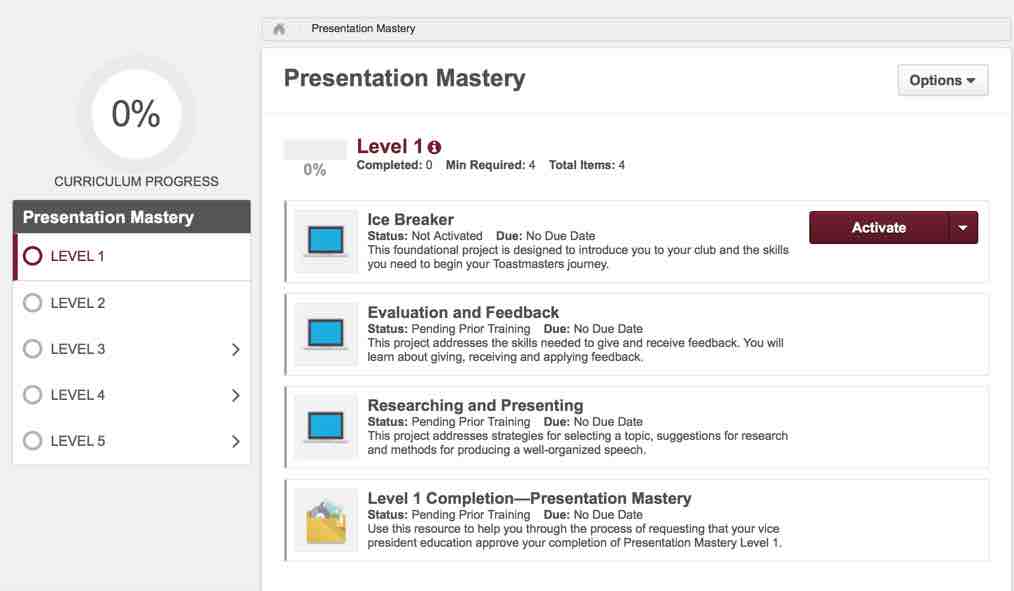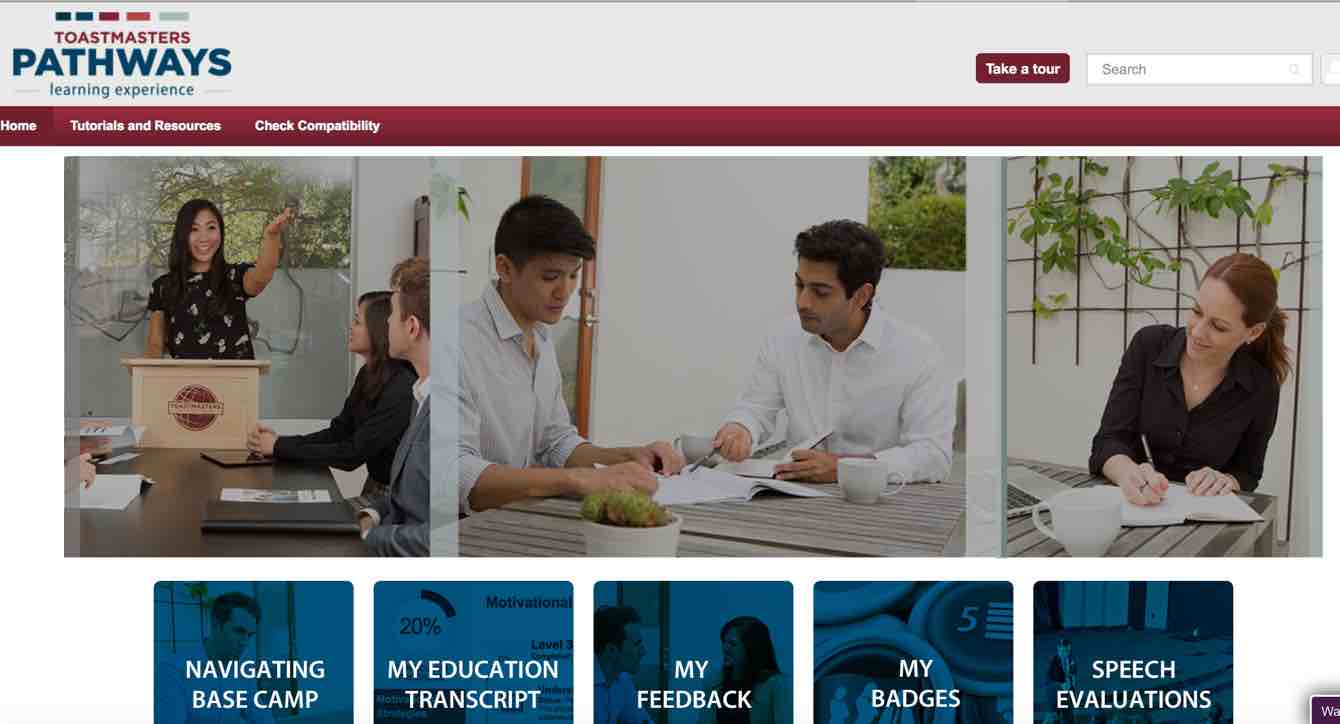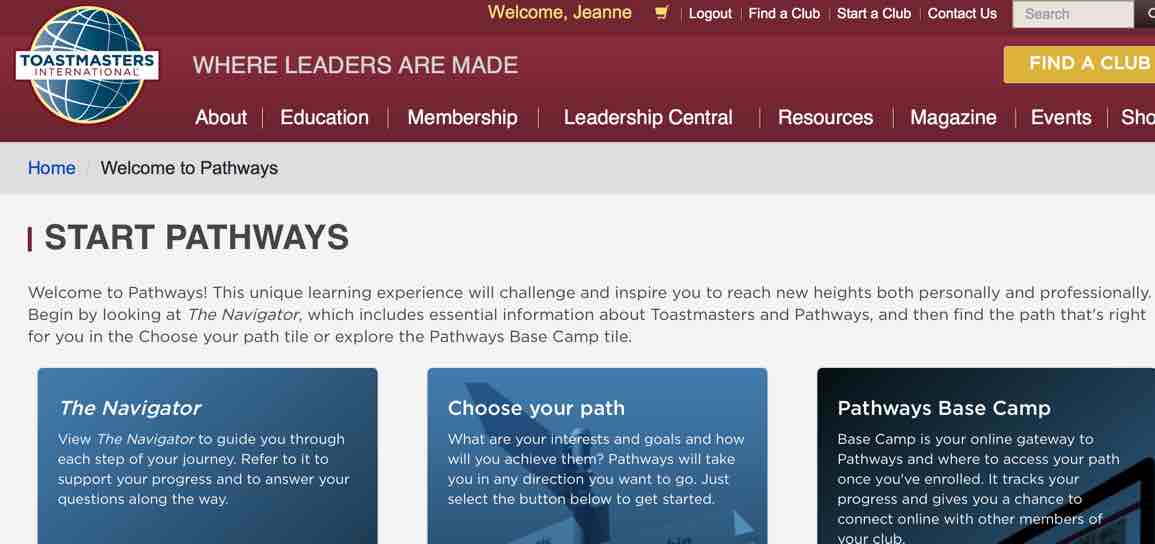I enrolled in Toastmasters Pathways and got oriented. Let’s take a look at a learning path curriculum. There are five levels each with a bunch of projects. I plan to blog as I go through Pathways. I’ll update this page updating descriptions or linking to the relevant blog posts from this page as I go.
Yes, I typed all this in. My club has a full set of advanced manuals so members can see what they are getting into before they order/commit to a manual. I’m trying to do something equivalent for Pathways. Not share all the content obviously. But to give a feel for the requirements and experience. For a better overview, see my comparison of paths.
I then found out that District 57 has it posted already. They have great PDF resources including a high level list of what is in each path.
I already have a DTM so I’m going through Pathways more rapidly to learn about the program.
Project statuses
Each project has one of the following statuses:
- Not activated – A project you are eligible to start, but haven’t yet. For example, the Icebreaker when you first sign in.
- In Progress – A project you have started or viewed.
- Completed – This project is completed.
- Pending Prior Training – This project will be unlocked after completing a pre-requsite project.
Level 1 – this level has 3 required projects + the submission
I’ve heard that level 1 is the same regardless of your path.
| Project | Description | Pre-req | My comments |
|---|---|---|---|
| Icebreaker | One speech | None | This the first speech you give in Toastmasters. For more details, see my Icebreaker blog page. |
| Evaluation and Feedback | Two speeches
Speech evaluation |
Icebreaker project | You can give the same speech two times or different speeches. For more details, see my Evaluation and Feedback blog post. |
| Research and Presenting | One speech | Icebreaker project | This project is a speech along with the necessary prep. For more details, see my Research and Presenting blog post. |
| Level Completion | Paperwork | All three projects in this level | This is for submitting to your club that you completed the level. In particular, you did four speeches and an evaluation to complete level 1. For more details, see my Submitting Level 1 blog post. |
Overall feedback on the level: This is almost half a CC. You give 4 speeches and do one evaluation. I find the “locked until pass pre-req” frustrating as you can’t plan for what is coming.
Level 2 – this level has 3 required projects + the submission
| Project | Description | Pre-req | My comments |
|---|---|---|---|
| Understanding your communication style | One speech | None | This project includes some short reading, a “test” on your communication style and a speech explaining it. See completing level 2. |
| Effective Body Language | Two speeches
Speech evaluation |
Icebreaker project | This project includes some short reading, a practice and a speech on any topic. See completing level 2. |
| Intro to Toastmasters Mentoring | One speech | Icebreaker project | This project includes some short reading and a speech about when you were a mentee. I gave this before my Level 1 was approved. See my blog post for more on the project itself and about completing level 2. |
| Level Completion | Paperwork | All three projects in this level | This is for submitting to your club that you completed the level. his level qualifies you to be a Pathways mentor. |
Level 3 – this level has one required project, two elective projects and the submission
- Persuasive Speaking
- At least two projects from this list: – this is one of the benefits of Pathways – choices! Note that you can take as many as you want.
- Deliver Social Speeches (a special occasion speech)
- Using Presentation Software
- Connect with Storytelling
- Creating Effective Visual Aids
- Using Descriptive Language
- Connect with your Audience
- Make Connections through Networking
- Focus on the Positive
- Inspire your Audience
- Prepare for an Interview
- Understanding Vocal Variety
- Active Listening
- Level completion – remember that you must serve as Toastmaster, Evaluator and Table Topics Master at least once before you can advance to level 4. You enter this in your profile as you go. This level qualifies you to get a letter to your manager.
Level 4 – this level has one required project, one elective project and the submission
- Managing a Difficult Audience
- At least one project from this list: – this is another benefit of Pathways; modern skills
- Create a Podcast
- Building a Social Media Presence
- Write a Compelling Blog
- Manage Online Meetings
- Q&A Session
- Public Relations Strategies
- Manage Projects Successfully
- Level Completion. This level qualifies you to get a letter to your manager.
Level 5 – this level has two required projects, one elective project and the submission
- Prepare to Speak Effectively
- At least one project from this list:
- Lessons Learned
- Moderate a Panel Discussion
- Ethical Leadership
- High Performance Leadership
- Leading in your Volunteer Organization
- Reflect on your Path
- Level Completion. This level qualifies you to get a letter to your manager and a certificate of proficiency.



